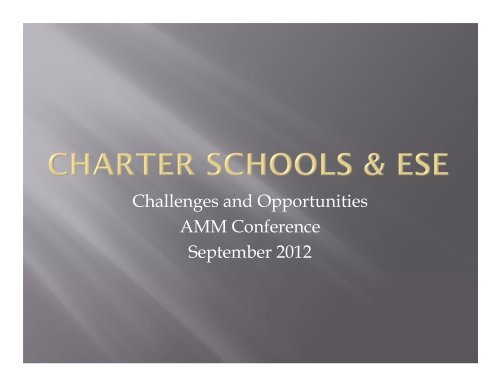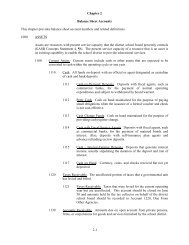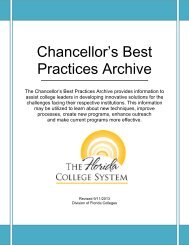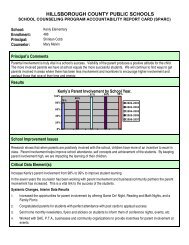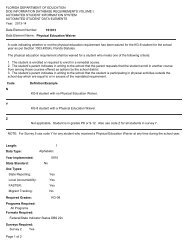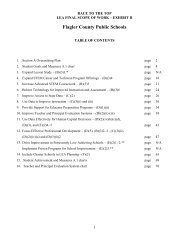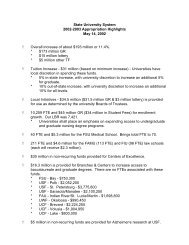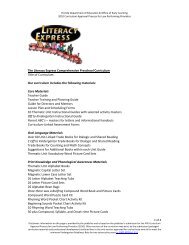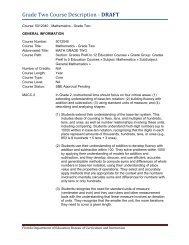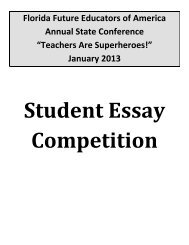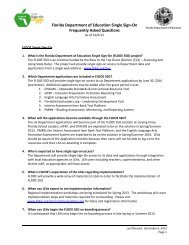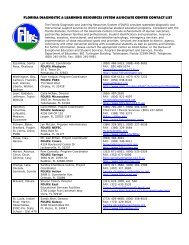Charter Schools and ESE - Florida Department of Education
Charter Schools and ESE - Florida Department of Education
Charter Schools and ESE - Florida Department of Education
You also want an ePaper? Increase the reach of your titles
YUMPU automatically turns print PDFs into web optimized ePapers that Google loves.
Challenges <strong>and</strong> Opportunities<br />
AMM Conference<br />
September 2012
<strong>Charter</strong> L<strong>and</strong>scape<br />
Overview <strong>of</strong> Research on <strong>Charter</strong>s <strong>and</strong> <strong>ESE</strong><br />
<strong>Florida</strong> Specific Data<br />
<strong>Florida</strong> Law/Rule<br />
Collaboration/Cooperation<br />
<strong>Department</strong> Initiatives
5,611 charter schools<br />
5.8% <strong>of</strong> all public schools<br />
41/50 states have charter laws<br />
538 new schools in 2011/12<br />
52.2% city (2009-10)<br />
67.6% freest<strong>and</strong>ing (no CMO/EMO) (2010)<br />
12.5% unionized (2009-2010)
577 <strong>Charter</strong>s (2012/13)<br />
183,390 student (2011/12)<br />
47 Districts<br />
Growth accelerated in recent years
**ERIC Inaccessible
Project Intersect: Research Report #7<br />
September 2007<br />
Survey to “broadly assess whether charter schools<br />
are enrolling <strong>and</strong> educating students with<br />
disabilities as an indicator <strong>of</strong> whether these new <strong>and</strong><br />
evolving public schools are fulfilling their<br />
fundamentally public mission….”<br />
Results (National)- 10.57% (charter) vs 11.67%<br />
(tradition)<br />
* 57% <strong>of</strong> schools surveyed were LEAs
“Students with Disabilities in <strong>Charter</strong> <strong>Schools</strong>:<br />
What we Know”<br />
11.2% vs. 12.1% (removing outliers)<br />
Differences in type <strong>of</strong> disability (+ SLD, -ID)<br />
Policy Tensions<br />
Prescriptive, highly regulated vs. autonomy <strong>and</strong><br />
flexibility<br />
Parental Choice<br />
“One reason parents seek to enroll…in a charter<br />
school is to avoid identification for special<br />
education.”
“A Case Study Comparison <strong>of</strong> <strong>Charter</strong> <strong>and</strong><br />
Traditional Public <strong>Schools</strong> in New Orleans<br />
Recovery School District: Selection Criteria <strong>and</strong><br />
Service Provision <strong>of</strong> Students with Disabilities”<br />
Evidence <strong>of</strong> Selective Admissions<br />
Possible Motivations: academic, economic
GAO Research Questions<br />
How do enrollment levels <strong>of</strong> SWD in charter <strong>and</strong><br />
traditional public schools compare, <strong>and</strong> what is<br />
known about the factors that may contribute to any<br />
difference<br />
How do charter schools reach out to SWD <strong>and</strong> what<br />
SPED services to charters provide<br />
What role do USED, SEAs, <strong>and</strong> other entities that<br />
oversee charter schools play in ensuring SWD have<br />
access to charter schools
SWD Enrollment: 11% (trad) vs. 8% (charter)<br />
“Little is known about the factors contributing<br />
to these differences”<br />
SWD represented 8-12% <strong>of</strong> all students at 23%<br />
<strong>of</strong> charters vs. 34% <strong>of</strong> traditional<br />
Higher % <strong>of</strong> charters enrolled more than 20%<br />
SWD compared to traditional<br />
Anecdotal evidence <strong>of</strong> selective screening- no<br />
comprehensive data to determine extent or<br />
whether such practices contribute to<br />
differences in enrollment levels
Traditional <strong>Charter</strong><br />
Total # <strong>of</strong> schools 3431 518<br />
Total # <strong>of</strong> Students 2,529542 182,795<br />
Totlal # <strong>of</strong> <strong>ESE</strong><br />
Students 335,223 16,953<br />
Percent <strong>of</strong> <strong>ESE</strong><br />
Students 13.25% 9.27%
Traditional <strong>Charter</strong><br />
% <strong>of</strong> schools with >50% <strong>ESE</strong> 5.54% 5.60%<br />
% <strong>of</strong> schools with 20-50% <strong>ESE</strong> 11.22% 4.83%<br />
% <strong>of</strong> schools with 0-20% <strong>ESE</strong> 76.81% 87.84%
http://www.floridaschoolchoice.org/pdf/Cha<br />
rter_Student_Achievement_2011.pdf
Federal <strong>and</strong> State Law<br />
State Board <strong>of</strong> <strong>Education</strong> Rule<br />
<strong>Charter</strong> Application<br />
<strong>Charter</strong> Contract
(10) Eligible Students<br />
(f) Students with disabilities <strong>and</strong> students served in<br />
English for Speakers <strong>of</strong> Other Languages programs shall<br />
have an equal opportunity <strong>of</strong> being selected for<br />
enrollment in a charter school.<br />
(16)(a) A charter school shall operate in<br />
accordance with its charter <strong>and</strong> shall be exempt<br />
from all statutes in chapters 1000-1013. However, a<br />
charter school shall be in compliance with the<br />
following statutes in chapters 1000-1013:<br />
3. Those statutes pertaining to the provision <strong>of</strong> services<br />
to students with disabilities.
(20) SERVICES.— (a)1. A sponsor shall<br />
provide certain administrative <strong>and</strong> educational<br />
services to charter schools. These services shall<br />
include contract management services; fulltime<br />
equivalent <strong>and</strong> data reporting services;<br />
exceptional student education administration<br />
services…
(17)(c) If the district school board is providing<br />
programs or services to students funded by<br />
federal funds, any eligible students enrolled in<br />
charter schools in the school district shall be<br />
provided federal funds for the same level <strong>of</strong><br />
service provided students in the schools<br />
operated by the district school board.
Title 20 U.S. Code, Sec. 1413(a)(5)<br />
(5) Treatment <strong>of</strong> charter schools <strong>and</strong> their students<br />
In carrying out this subchapter with respect to charter schools that are public<br />
schools <strong>of</strong> the local educational agency, the local educational agency—<br />
(A) serves children with disabilities attending those charter schools in the<br />
same manner as the local educational agency serves children with disabilities in<br />
its other schools, including providing supplementary <strong>and</strong> related services on site<br />
at the charter school to the same extent to which the local educational agency has<br />
a policy or practice <strong>of</strong> providing such services on the site to its other public<br />
schools; <strong>and</strong><br />
(B) provides funds under this subchapter to those charter schools—<br />
(i) on the same basis as the local educational agency provides funds<br />
to the local educational agency’s other public schools, including proportional<br />
distribution based on relative enrollment <strong>of</strong> children with disabilities; <strong>and</strong><br />
(ii) at the same time as the agency distributes other Federal funds<br />
to the agency’s other public schools, consistent with the State’s charter school<br />
law.
Model <strong>Charter</strong> Application-<br />
All applicants must use<br />
Developed in collaboration with Operators <strong>and</strong><br />
Districts<br />
Multiple prompts related to students below grade<br />
level<br />
Revised <strong>ESE</strong> Section
Section 6: Exceptional Students<br />
Please indicate the level <strong>of</strong> service that the school will provide to students with disabilities by selecting<br />
from the list below.<br />
The school will serve students with disabilities whose needs can be met in a regular classroom environment (at least<br />
80% <strong>of</strong> instruction occurring in a class with non-disabled peers) with the provision <strong>of</strong> reasonable supplementary<br />
supports <strong>and</strong> services <strong>and</strong>/or modifications <strong>and</strong> accommodations.<br />
The school will serve students with disabilities whose needs can be met in a regular classroom <strong>and</strong> resource room<br />
combination (between 40%-80% <strong>of</strong> instruction occurring in a class with non-disabled peers) with the provision <strong>of</strong><br />
reasonable supplementary supports <strong>and</strong> services <strong>and</strong>/or modifications <strong>and</strong> accommodations.<br />
The school will serve students with disabilities whose needs can be met in a separate classroom (less than 40% <strong>of</strong><br />
instruction occurring in a class with non-disabled peers).<br />
Describe how the school will ensure that students with disabilities will have an equal opportunity <strong>of</strong><br />
being selected for enrollment in the charter school.<br />
Describe how the school will work with the sponsor to ensure the charter school is the appropriate<br />
placement for each student with a disability, based on the student’s needs.<br />
Describe how the school will utilize the regular school facilities <strong>and</strong> adapt them to the needs <strong>of</strong><br />
exceptional students to the maximum extent appropriate, including the use <strong>of</strong> supplementary aids<br />
<strong>and</strong> services.<br />
Describe how the school’s effectiveness in serving exceptional education students will be evaluated.<br />
Explain how exceptional students who enter the school below grade level will be engaged in <strong>and</strong><br />
benefit from the curriculum.<br />
Provide the school’s projected population <strong>of</strong> students with disabilities <strong>and</strong> describe how the projection<br />
was made.<br />
Identify the staffing plan, based on the above projection, for the school’s special education program,<br />
including the number <strong>and</strong> qualifications <strong>of</strong> staff.<br />
Describe how the school will serve gifted <strong>and</strong> talented students.
Section 3: Students<br />
A) Eligible Students [as described in Application]<br />
B) Grades Served<br />
C) Class Size (If Applicable)<br />
D) Annual Projected Enrollment [deadline for submission to Sponsor]<br />
E) Annual Capacity Determination [deadline for submission to Sponsor]<br />
F) Admissions <strong>and</strong> Enrollment Plan [as described in Application]<br />
G) Maintenance <strong>of</strong> Student Records as Required by Statute<br />
H) Exceptional Student <strong>Education</strong><br />
1) Non-discriminatory Policy<br />
2) Sponsor’s responsibilities<br />
3) School responsibilities<br />
4) Services covered by the five percent (5%) administrative fee<br />
5) Due Process Hearing<br />
I) Dismissal Policies <strong>and</strong> Procedures [as described in Application]
Student Application/Enrollment Process<br />
Should application include questions about IEP?<br />
Appropriate?<br />
Role <strong>of</strong> LEA vs School<br />
Supports from LEA?
Student Application/Enrollment Process<br />
Clearly defined process for determining<br />
appropriateness <strong>of</strong> school setting<br />
Timelines for IEP meetings<br />
Supports available to school during pendency<br />
Transparency<br />
Public Lottery/Selection<br />
Auditable process
Role <strong>of</strong> LEA vs. School<br />
Clearly articulated charter contracts- list <strong>and</strong> define<br />
responsibilities<br />
Underst<strong>and</strong>ing that continuum <strong>of</strong> placements is LEA<br />
responsibility<br />
Agreed upon monitoring practices
Supports from LEA<br />
Clearly articulated charter contract<br />
Clearly articulated process for allocating IDEA<br />
resources
Dissemination Grant<br />
St<strong>and</strong>ards for HQ Authorizing in <strong>Florida</strong><br />
Coordination between BEES <strong>and</strong> IEPC


